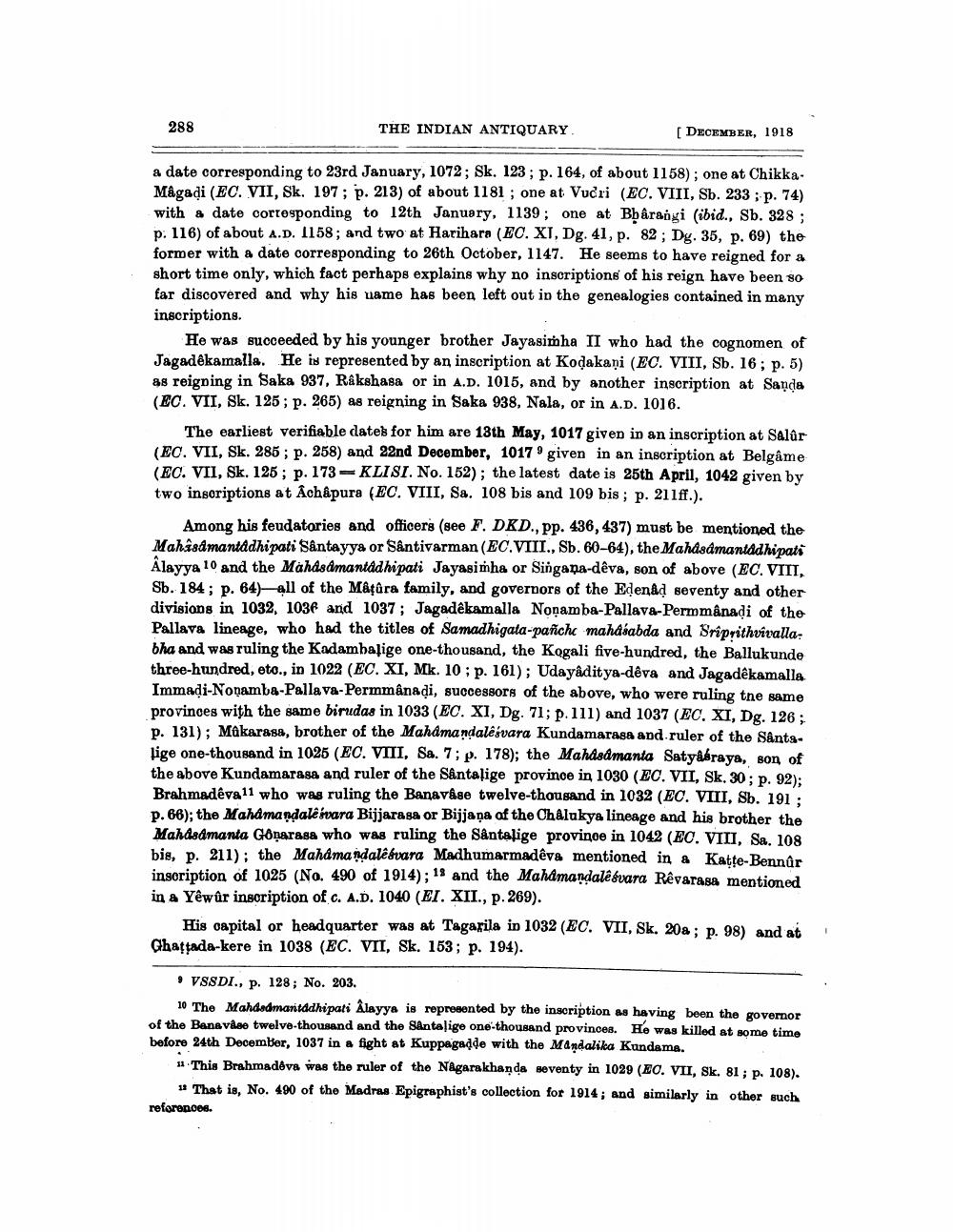________________
288
THE INDIAN ANTIQUARY
[ DECEMBER, 1918
a date corresponding to 23rd January, 1072; Sk. 123; p. 164, of about 1158); one at ChikkaMågadi (EC. VII, Sk. 197; p. 213) of about 1181 ; one at Vudri (EC. VIII, Sb. 233; p. 74) with a date corresponding to 12th January, 1139; one at Bharangi (ibid., Sb. 328 ; p. 116) of about A.D. 1158; and two at Harihara (EO. XI, Dg. 41, p. 82 ; Dy. 35. p. 69) the former with a date corresponding to 26th October, 1147. He seems to have reigned for a short time only, which fact perhaps explains why no inscriptions of his reign have been so far discovered and why his name has been left out in the genealogies contained in many inscriptions.
He was succeeded by his younger brother Jayasinha II who had the cognomen of Jagadēkamalla. He is represented by an inscription at Kodakani (EC. VIII, Sb. 16; p. 5) 88 reigning in Saka 937, Rakshasa or in A.D. 1015, and by another inscription at Sanda (EC. VII, Sk, 125; p. 265) as reigning in Saka 938, Nala, or in A.D. 1016.
The earliest verifiable dates for him are 13th May, 1017 given in an inscription at Salur (EC. VII, Sk. 285 ; p. 258) and 22nd December, 1017 given in an inscription at Belgâme (EC. VII, Sk. 125; p. 173-KLISI. No. 152); the latest date is 25th April, 1042 given by two insoriptions at Ach&pura (EC. VIII, Sa. 108 bis and 109 bis : p. 211ff.).
Among his feudatories and officers (see F. DKD., pp. 436, 437) must be mentioned the Mahîsdmantadhipati Sântayya or Sântivarman (EC. VIII., Sb. 60-64), the Mahasamantadhipati Alayya 10 and the Mahasamantadhipati Jayasimha or Singana-dêva, son of above (EC. VIII, Sb. 184; p. 64) all of the Mâfâra family, and governors of the Edenåd seventy and other divisions in 1032, 1034 and 1037; Jagadêkamalla Noņamba-Pallava-Permmânadi of the Pallava lineage, who had the titles of Samadhigata-pañche mahasabda and Sriprithvivalla bha and was ruling the Kadambalige one-thousand, the Kogali five-hundred, the Ballukunde three-hundred, eto., in 1022 (EC. XI, Mk. 10 ; p. 161); Udayâditya-deva and Jagadêkamalla Immadi-Nonamba-Pallava-Permmånadi, successors of the above, who were ruling the same provinces with the same birudas in 1033 (EC. XI, Dg. 71; p. 111) and 1037 (EC, XI, Dg. 126: p. 131): Môkarasa, brother of the Mahdmandalesvara Kundamarasa and ruler of the Santslige one-thousand in 1025 (EC. VIII, Sa. 7; p. 178); the Mahdsdmanta Satyasraya, son of the above Kundamarasa and ruler of the Santalige province in 1030 (EC. VII, Sk. 30; p. 92): Brahmadêva 11 who was ruling the Banavåse twelve-thousand in 1032 (EC. VIII, Sb. 191 : P. 66); the Mahamandale svara Bijjaraga or Bijjana of the Chalukya lineage and his brother the Mahdsdmanta Gonaraga who was ruling the Sântalige province in 1042 (EC. VIII, Sa. 108 bie, p. 211): the Mahamandalesvara Madhumarmadêva mentioned in a Katte-Bennûr insoription of 1025 (No. 490 of 1914); " and the Mahamandalesvara Rêvarasa mentioned in a Yêwûr inscription of c. A.D. 1040 (EI. XII., p.269).
His capital or headquarter was at Tagarila in 1032 (EC. VII, Sk. 20a ; p. 98) and at Ghatada-kere in 1038 (EC. VII, Sk. 153; p. 194).
• VSSDI., p. 128; No. 203.
10 Tho Mahdadmaritadhipati Alayya is represented by the inscription as having been the governor of the Banavico twelve-thousand and the Santalige one-thousand provinces. He was killed at some time before 24th December, 1037 in a fight at Kuppagadde with the Mandalika Kandama.
1. This Brahmaddva was the ruler of the Nagarakhanda soventy in 1029 (EC. VII, Sk. 81 ; p. 108).
11 That is, No. 490 of the Madras Epigraphist's collection for 1914; and similarly in other such reforences.




